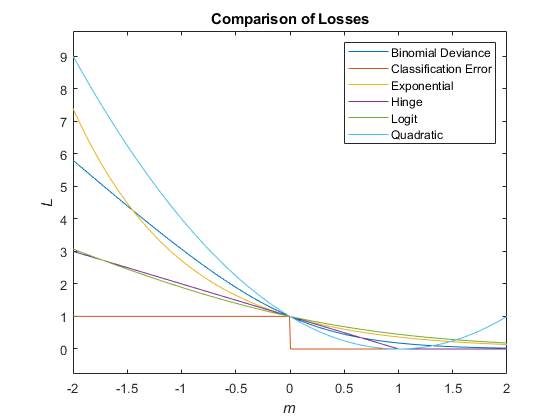kfoldLoss
交差検証済みカーネル分類モデルの分類損失
説明
loss = kfoldLoss(CVMdl)ClassificationPartitionedKernel) CVMdl によって取得した分類損失を返します。kfoldLoss は、すべての分割について、学習分割観測値に対して学習をさせたモデルを使用して、検証分割観測値の分類損失を計算します。
既定では、kfoldLoss は分類誤差を返します。
loss = kfoldLoss(CVMdl,Name,Value)
例
ionosphere データ セットを読み込みます。このデータ セットには、レーダー反射についての 34 個の予測子と、不良 ('b') または良好 ('g') というラベルが付いた 351 個の二項反応が含まれています。
load ionosphereこのデータを使用して、バイナリ カーネル分類モデルを交差検証します。
CVMdl = fitckernel(X,Y,'Crossval','on')
CVMdl =
ClassificationPartitionedKernel
CrossValidatedModel: 'Kernel'
ResponseName: 'Y'
NumObservations: 351
KFold: 10
Partition: [1×1 cvpartition]
ClassNames: {'b' 'g'}
ScoreTransform: 'none'
Properties, Methods
CVMdl は ClassificationPartitionedKernel モデルです。既定では、10 分割交差検証が実行されます。異なる分割数を指定するには、'Crossval' ではなく名前と値のペアの引数 'KFold' を指定します。
交差検証分類損失を推定します。既定では、分類誤差が計算されます。
loss = kfoldLoss(CVMdl)
loss = 0.0940
または、名前と値のペアの引数 'Mode','individual' を kfoldLoss で指定することにより、分割ごとの分類誤差を取得できます。
ionosphere データ セットを読み込みます。このデータ セットには、レーダー反射についての 34 個の予測子と、不良 ('b') または良好 ('g') というラベルが付いた 351 個の二項反応が含まれています。
load ionosphereこのデータを使用して、バイナリ カーネル分類モデルを交差検証します。
CVMdl = fitckernel(X,Y,'Crossval','on')
CVMdl =
ClassificationPartitionedKernel
CrossValidatedModel: 'Kernel'
ResponseName: 'Y'
NumObservations: 351
KFold: 10
Partition: [1×1 cvpartition]
ClassNames: {'b' 'g'}
ScoreTransform: 'none'
Properties, Methods
CVMdl は ClassificationPartitionedKernel モデルです。既定では、10 分割交差検証が実行されます。異なる分割数を指定するには、'Crossval' ではなく名前と値のペアの引数 'KFold' を指定します。
次の線形損失を評価する無名関数を作成します。
は観測値 j の重み、 は応答 j (陰性クラスの場合は –1、それ以外の場合は 1)、 は観測値 j の生の分類スコアです。
linearloss = @(C,S,W,Cost)sum(-W.*sum(S.*C,2))/sum(W);
カスタム損失関数は特定の形式で記述しなければなりません。カスタム損失関数の記述に関するルールについては、名前と値のペアの引数 'LossFun' を参照してください。
線形損失関数を使用して交差検証分類損失を推定します。
loss = kfoldLoss(CVMdl,'LossFun',linearloss)loss = -0.7792
入力引数
交差検証済みのバイナリ カーネル分類モデル。ClassificationPartitionedKernel モデル オブジェクトを指定します。ClassificationPartitionedKernel モデルは、fitckernel を使用し、交差検証の名前と値のペアの引数のいずれかを指定することにより作成できます。
推定値を取得するため、kfoldLoss はカーネル分類モデルの交差検証に使用したものと同じデータ (X および Y) を適用します。
名前と値の引数
オプションの引数のペアを Name1=Value1,...,NameN=ValueN として指定します。ここで、Name は引数名で、Value は対応する値です。名前と値の引数は他の引数の後に指定しなければなりませんが、ペアの順序は重要ではありません。
R2021a より前では、名前と値をそれぞれコンマを使って区切り、Name を引用符で囲みます。
例: kfoldLoss(CVMdl,'Folds',[1 3 5]) は、分類損失の計算に 1 番目、3 番目および 5 番目の分割のみを使用することを指定します。
予測の分割インデックス。'Folds' および正の整数の数値ベクトルで構成されるコンマ区切りのペアとして指定します。Folds の要素は 1 から CVMdl.KFold の範囲でなければなりません。
予測用の Folds で指定された分割のみが使用されます。
例: 'Folds',[1 4 10]
データ型: single | double
損失関数。'LossFun' と組み込みの損失関数名または関数ハンドルから構成されるコンマ区切りのペアとして指定します。
次の表は、使用できる損失関数の一覧です。対応する値を使用していずれかを指定します。
値 説明 "binodeviance"二項分布からの逸脱度 "classifcost"観測誤分類コスト "classiferror"10 進数の誤分類率 "exponential"指数損失 "hinge"ヒンジ損失 "logit"ロジスティック損失 "mincost"最小予測誤分類コスト (事後確率である分類スコアの場合) "quadratic"二次損失 'mincost'は、事後確率である分類スコアに適しています。カーネル分類モデルの場合、既定の設定ではロジスティック回帰学習器は事後確率を分類スコアとして返しますが、SVM 学習器はそうではありません (kfoldPredictを参照)。関数ハンドル表記を使用して、独自の関数を指定します。
nはX内の観測値の個数、Kは異なるクラスの個数 (numel(CVMdl.ClassNames)、CVMdlは入力モデル) であると仮定します。使用する関数のシグネチャは次のようになっていなければなりません。lossvalue =lossfun(C,S,W,Cost)出力引数
lossvalueはスカラーです。関数名 (
lossfun) を指定します。Cはn行K列の logical 行列であり、対応する観測値が属するクラスを各行が示します。列の順序はCVMdl.ClassNamesのクラスの順序に対応します。各行について観測値
pがクラスqに属する場合はC(p,q) = 1を設定することにより、Cを作成します。行pの他のすべての要素を0に設定します。Sは、分類スコアのn行K列の行列です。列の順序はCVMdl.ClassNamesのクラスの順序に対応します。Sは分類スコアの行列で、kfoldPredictの出力と同様です。Wは、観測値の重みのn行 1 列の数値ベクトルです。Wを渡す場合、重みは合計が1になるように正規化されます。Costは、誤分類コストの、K行K列の数値行列です。たとえば、Cost = ones(K) – eye(K)は、正しい分類のコストとして0を、誤分類のコストとして1を指定します。
例: 'LossFun',@lossfun
データ型: char | string | function_handle
出力の集約レベル。'Mode' と 'average' または 'individual' から構成されるコンマ区切りのペアとして指定します。
次の表は値を説明します。
| 値 | 説明 |
|---|---|
'average' | 出力は、すべての分割の平均を表すスカラー値です。 |
'individual' | 出力は、分割ごとに 1 つずつの値が含まれている長さ k のベクトルです。k は分割数です。 |
例: 'Mode','individual'
出力引数
詳細
"分類損失" 関数は分類モデルの予測誤差を評価します。複数のモデルで同じタイプの損失を比較した場合、損失が低い方が予測モデルとして優れていることになります。
以下のシナリオを考えます。
L は加重平均分類損失です。
n は標本サイズです。
yj は観測されたクラス ラベルです。陰性クラスを示す -1 または陽性クラスを示す 1 (あるいは、
ClassNamesプロパティの最初のクラスを示す -1 または 2 番目のクラスを示す 1) を使用して符号化されます。f(Xj) は予測子データ X の観測値 (行) j に対する陽性クラスの分類スコアです。
mj = yjf(Xj) は、yj に対応するクラスに観測値 j を分類する分類スコアです。正の値の mj は正しい分類を示しており、平均損失に対する寄与は大きくありません。負の値の mj は正しくない分類を示しており、平均損失に大きく寄与します。
観測値 j の重みは wj です。観測値の重みは、その合計が
Priorプロパティに格納された対応するクラスの事前確率になるように正規化されます。そのため、次のようになります。
この状況では、名前と値の引数 LossFun を使用して指定できる、サポートされる損失関数は次の表のようになります。
| 損失関数 | LossFun の値 | 式 |
|---|---|---|
| 二項分布からの逸脱度 | "binodeviance" | |
| 観測誤分類コスト | "classifcost" | ここで、 はスコアが最大のクラスに対応するクラス ラベル、 は真のクラスが yj である場合に観測値をクラス に分類するユーザー指定のコストです。 |
| 10 進数の誤分類率 | "classiferror" | ここで、I{·} はインジケーター関数です。 |
| クロスエントロピー損失 | "crossentropy" |
加重クロスエントロピー損失は次となります。 ここで重み は、合計が 1 ではなく n になるように正規化されます。 |
| 指数損失 | "exponential" | |
| ヒンジ損失 | "hinge" | |
| ロジスティック損失 | "logit" | |
| 最小予測誤分類コスト | "mincost" |
重み付きの最小予測分類コストは、次の手順を観測値 j = 1、...、n について使用することにより計算されます。
最小予測誤分類コスト損失の加重平均は次となります。 |
| 二次損失 | "quadratic" |
既定のコスト行列 (正しい分類の場合の要素値は 0、誤った分類の場合の要素値は 1) を使用する場合、"classifcost"、"classiferror"、および "mincost" の損失の値は同じです。既定以外のコスト行列をもつモデルでは、ほとんどの場合は "classifcost" の損失と "mincost" の損失が等価になります。これらの損失が異なる値になる可能性があるのは、最大の事後確率をもつクラスへの予測と最小の予測コストをもつクラスへの予測が異なる場合です。"mincost" は分類スコアが事後確率の場合にしか適さないことに注意してください。
次の図では、1 つの観測値のスコア m に対する損失関数 ("classifcost"、"crossentropy"、および "mincost" を除く) を比較しています。いくつかの関数は、点 (0,1) を通過するように正規化されています。

拡張機能
この関数は、GPU 配列を完全にサポートします。詳細は、GPU での MATLAB 関数の実行 (Parallel Computing Toolbox)を参照してください。
バージョン履歴
R2018b で導入kfoldLoss は GPU 配列を完全にサポートします。
R2023b 以降では、次の分類モデルのオブジェクト関数において、予測子に欠損値がある観測値が再代入 ("resub") と交差検証 ("kfold") による分類エッジ、損失、マージン、および予測の計算でその一部として使用されます。
以前のリリースでは、予測子に欠損値がある観測値は再代入と交差検証の計算で省略されていました。
入力モデル オブジェクトに学習させるときに既定以外のコスト行列を指定すると、関数 kfoldLoss で以前のリリースとは異なる値が返されます。
関数 kfoldLoss は、W プロパティに格納された観測値の重みを使用します。さらに、名前と値の引数 LossFun を "classifcost" または "mincost" として指定した場合、関数は Cost プロパティに格納されたコスト行列を使用します。W プロパティと Cost プロパティの値を関数で使用する方法については変更されていません。ただし、既定以外のコスト行列をもつモデルについて入力モデル オブジェクトに格納されるプロパティの値が変更されたため、関数から異なる値が返されることがあります。
プロパティの値の変更に関する詳細については、Cost プロパティにユーザー指定のコスト行列を格納を参照してください。
ソフトウェアでコスト行列、事前確率、および観測値の重みを以前のリリースと同じように扱う場合は、誤分類コスト行列に応じた事前確率と観測値の重みの調整の説明に従って、既定以外のコスト行列の事前確率と観測値の重みを調整します。その後、分類モデルに学習させるときに、調整後の事前確率と観測値の重みを名前と値の引数 Prior と Weights を使用して指定し、既定のコスト行列を使用します。
MATLAB Command
You clicked a link that corresponds to this MATLAB command:
Run the command by entering it in the MATLAB Command Window. Web browsers do not support MATLAB commands.
Web サイトの選択
Web サイトを選択すると、翻訳されたコンテンツにアクセスし、地域のイベントやサービスを確認できます。現在の位置情報に基づき、次のサイトの選択を推奨します:
また、以下のリストから Web サイトを選択することもできます。
最適なサイトパフォーマンスの取得方法
中国のサイト (中国語または英語) を選択することで、最適なサイトパフォーマンスが得られます。その他の国の MathWorks のサイトは、お客様の地域からのアクセスが最適化されていません。
南北アメリカ
- América Latina (Español)
- Canada (English)
- United States (English)
ヨーロッパ
- Belgium (English)
- Denmark (English)
- Deutschland (Deutsch)
- España (Español)
- Finland (English)
- France (Français)
- Ireland (English)
- Italia (Italiano)
- Luxembourg (English)
- Netherlands (English)
- Norway (English)
- Österreich (Deutsch)
- Portugal (English)
- Sweden (English)
- Switzerland
- United Kingdom (English)